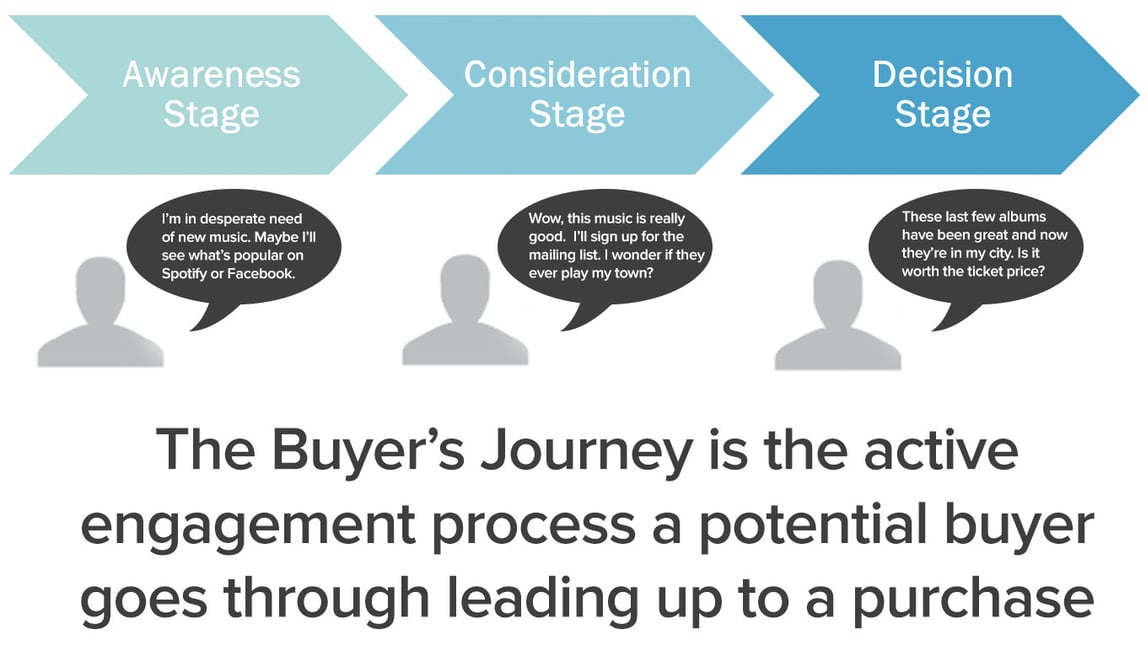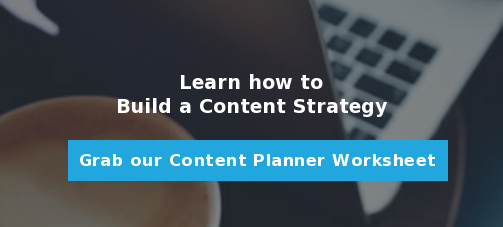
So you're marketing a successful artist or band who's killing it live. They rake in at the merch table, but their website is a ghost town and you can't help but wonder "What are we doing wrong?"
Let me introduce you to your secret weapon that's about to change everything: Inbound Marketing.
It’s a way of structuring your marketing to focus on content, SEO, and an effective sales funnel in order to drastically increase “leads” for you business marketers — or in the artist-sales side of the music business, fans. We've consistently seen fantastic results from implementing its methodology across a variety of businesses.
These results have been so good — we just had to share them. It'd be selfish not to, right? So here it is, an overview of this magical marketing juju called Inbound Marketing.
What is Inbound Marketing?
-
It’s the best way to turn strangers into customers and promoters of your brand.
-
It’s strategic content marketing.
-
It’s marketing that consistently brings people in instead of focusing on one-off, interruption advertising strategies. In other words, it builds lasting relationships and content that brings in continual fans over time — sometimes even years after its original push.
An easy way to think about Inbound is to compare it to its outdated and ineffective uncle, Interruption Marketing. Everyone is familiar with interruption marketing — the pop-up ads, the emails you didn't sign up for, the print mail you throw away, the complete lack of customer permission and intent to interrupt your focus and bring attention to a brand.
To be fair, interruption marketing used to work for most businesses, but those days are gone. Think about Inbound Marketing as a user-friendly, permission-centric, content-based marketing methdology that focuses on developing relationships with people before, during, and after they become customers by supplying well-timed and useful information the potential client is searching for.
There’s a lot to cover about Inbound, and all the details cannot be covered in this post, but we can definitely give you a high level overview to see what Inbound is about and how it can revolutionize your digital music marketing strategy. We’ll hit two of the main Inbound points today.
The Inbound Methodology
This is the inbound methodology as condensed as humanly possible. We want to reach potential customers at all designated “lifecycle stages” by attracting, converting, closing, and ultimately delighting each customer by using appropriate content at the right times to achieve the best marketing value for our dollar.
So a music fan's lifecycle could be:
1. Attracted
through initial exposure to an artist’s music through a blog or social media.
2. Converted
by being engaged with a call-to-action to download a free single, added to the email list, and sent engaging content.
3. Closed
by being sent a discount to purchase concert tickets or the new album.
4. Delighted
through continued email and social marketing.
Or here’s an example of how a customer might interact with a Tour Production company:
1. Attracted
through initial exposure via the company blog or social media.
2. Converted
by being engaged with a call-to-action to download a free input list worksheet and added to the email list.
3. Closed
by being sent more engaging content such as a free tour production consultation and through offering a discount for new clients.
4. Delighted
again through continued email and social marketing.
The Buyer's Journey
Another main component of the inbound methodology is to understand your "Buyer's Journey". This works hand in hand with the inbound overview chart above. Essentially, this is the journey into the sales funnel, not the sales funnel itself — so basically the Attract and Convert stages from above.

As you can see, there are three stages that reflect the typical thought process an individual has throughout a purchasing decision: awareness, consideration, and decision.
Let’s take take a look at two different examples:
For a music fan:
Awareness Stage:
A listener hears a friend talking about the artist on Social Media.
Consideration Stage:
The listener decides to follow the artist on Social Media or an email list to see what this is all about.
Decision Stage:
The listener is blown away by the personality and music from the artist and decides to see for themselves at a live show.
For a potential customer of tour production business:
Awareness Stage:
The buyer knows their act's live performance needs to expand and is considering professional options. They are unsure if they should outsource the work, so they begin to read a variety of materials on how to better a band's live performance.
Consideration Stage:
The buyer decides hiring a tour production team is the right move for them after reading blogs and talking to fellow professionals. They seek out materials noting what a good tour production team offers and how to choose the right one.
Decision Stage:
The buyer begins comparing different tour production companies by compiling a list based on recommendations and websites that caught his/her attention.
Now, let’s briefly reiterate what I mentioned earlier. You want to place specific content that relates to that potential customer within their current stage of the Buyer's Journey. It’s all about timing.
For example, in the consideration stage of our potential tour production client, you could have blogs talking about everything a good tour production company offers. At the end of that blog, you could have a “Overview of Our Services” download available for the decision stage. If they download the overview, you could automatically enroll them in an email automation workflow that offers a free tour production consultation. Pretty, cool, right?
You want to place specific content that relates to that potential customer at whatever stage within the Buyer Cycle they are in. It’s all about timing.
To wrap up...
The trick is to produce a variety of content for buyers at all stages. Part of this is simply consistency, but a lot of this is knowing where most of your buyers fall in their journey.
To do so, we have to understand:
- which fans / subscribers engage with you the most
- which buyers have purchased from in the past
- what routes, segments, or content give you the best conversion from "stranger" to "customer" and even "promoter"
For example, If you had a VIP vinyl with a limited supply, would it be more efficient to reachout to your entire fan base or just the segments you know are already interested?
Another important attribute of Inbound is to make these fans or customers feel more valued at each stage. Your brand is a story — let people take part in it.
Finally, keep in mind that content creation, publishing and analytics tools all work together like a well-oiled machine — allowing you to focus on publishing the right content in the right place at the right time.
Your brand is a story — let people take part in it.
Inbound can sound complicated, but it doesn’t have to be. It uses simple tools but employs them in an effective manner. It runs best when all elements of inbound are working fluidly together and are being consistently observed and improved upon. Digital marketing changes rapidly — you have to be observing to stay ahead, and there are countless tools that can help put numbers behind your efforts in order to draw actionable insights.
Here are a few tools to help you get started with Inbound Marketing
LeadIn - Track how users interact on your site.
Facebook Audience Pixels - Gather information about your website visitors and optimize Facebook’s algorithms for effective ad campaigns.
Buffer, Hootsuite, or Followerwonk - Track your content on Social Networks. Use this along with LeadIn to see you best referral of vistors.
Mailchimp - Because it’s our favorite email marketing software.
SumAll - High level fan trends.
Artist Growth - Artist Platform to help track revenue.
Looking for the next step? Try part 2 in our Music Marketing series here.
Thanks to Hubspot for a few of the images. Thoughts or questions? Let's chat below!


